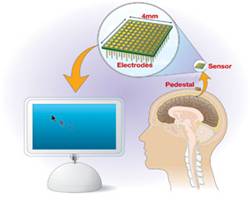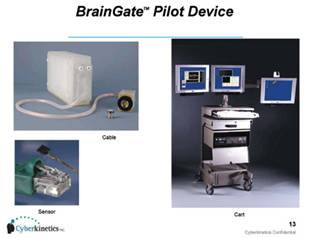





Published on Nov 30, 2023
BrainGate is a brain implant system developed by the bio-tech company Cyberkinetics in 2003 in conjunction with the Department of Neuroscience at Brown University. The device was designed to help those who have lost control of their limbs, or other bodily functions, such as patients with amyotrophic lateral sclerosis (ALS) or spinal cord injury.
The computer chip, which is implanted into the brain , monitors brain activity in the patient and converts the intention of the user into computer commands. Cyberkinetics describes that "such applications may include novel communications interfaces for motor impaired patients, as well as the monitoring and treatment of certain diseases which manifest themselves in patterns of brain activity, such as epilepsy and depression."
Currently the chip uses 100 hair-thin electrodes that sense the electro-magnetic signature of neurons firing in specific areas of the brain, for example, the area that controls arm movement. The activities are translated into electrically charged signals and are then sent and decoded using a program, which can move either a robotic arm or a computer cursor. According to the Cyberkinetics' website, three patients have been implanted with the BrainGate system. The company has confirmed that one patient ( Matt Nagle ) has a spinal cord injury, while another has advanced ALS.
The BrainGate Neural Interface System is currently the subject of a pilot clinical trial being conducted under an Investigational Device Exemption (IDE) from the FDA. The system is designed to restore functionality for a limited, immobile group of severely motor-impaired individuals. It is expected that people using the BrainGate System will employ a personal computer as the gateway to a range of self-directed activities. These activities may extend beyond typical computer functions (e.g., communication) to include the control of objects in the environment such as a telephone, a television and lights.
The BrainGate System is based on Cyberkinetics' platform technology to sense, transmit, analyze and apply the language of neurons. The System consists of a sensor that is implanted on the motor cortex of the brain and a device that analyzes brain signals. The principle of operation behind the BrainGate System is that with intact brain function, brain signals are generated even though they are not sent to the arms, hands and legs. The signals are interpreted and translated into cursor movements, offering the user an alternate "BrainGate pathway" to control a computer with thought, just as individuals who have the ability to move their hands use a mouse.

Cyberkinetics is further developing the BrainGate System to potentially provide limb movement to people with severe motor disabilities. The goal of this development program would be to allow these individuals to one day use their own arms and hands again. Limb movement developments are currently at the research stage and are not available for use with the existing BrainGate System. In addition Cyberkinetics is developing products to allow for robotic control, such as a thought-controlled wheelchair.
The braingate pilot device consists of a Sensor of the size of a contact lens, a cable and pedestal, which connects the chip to the computer, a cart which consists the signal processing unit .

The BrainGate Neural Interface Device is a proprietary brain-computer interface that consists of an internal neural signal sensor and external processors that convert neural signals into an output signal under the users own control. The sensor consists of a tiny chip smaller than a baby aspirin, with one hundred electrode sensors each thinner than a hair that detect brain cell electrical activity.
The chip is implanted on the surface of the brain in the motor cortex area that controls movement. In the pilot version of the device, a cable connects the sensor to an external signal processor in a cart that contains computers. The computers translate brain activity and create the communication output using custom decoding software. Importantly, the entire BrainGate system was specifically designed for clinical use in humans and thus, its manufacture, assembly and testing are intended to meet human safety requirements. Five quadriplegics patients in all are enrolled in the pilot study, which was approved by the U.S. Food and Drug Administration (FDA).
Existing technology stimulates muscle groups that can make an arm move. The problem Surgenor and his team faced was in creating an input or control signal. With the right control signal they found they could stimulate the right muscle groups to make arm movement.
Neurons are cells that use a language of electrical impulses to communicate messages from the brain to the rest of the body. At Cyberkinetics, we have the technology to sense, transmit, analyze and apply the language of neurons. We are developing products to restore function, as well as to monitor, detect, and respond to a variety of neurological diseases and disorders.
Cyberkinetics offers a systems approach with a core technology to sense, transmit, analyze and apply the language of neurons in both short and long-term settings. Our platform technology is based on the results of several years of research and development at premier academic institutions such as Brown University, the Massachusetts Institute of Technology, Emory University, and the University of Utah.
Cyberkinetics' unique technology is able to simultaneously sense the electrical activity of many individual neurons. Our sensor consists of a silicon array about the size of a baby aspirin that contains one hundred electrodes, each thinner than a human hair. The array is implanted on the surface of the brain. In the BrainGate™ Neural Interface System, the array is implanted in the area of the brain responsible for limb movement. In other applications the array may be implanted in areas of the brain responsible for other body processes.
The human brain is a super computer with the ability to instantaneously process vast amounts of information. Cyberkinetics' technology allows for an extensive amount of electrical activity data to be transmitted from neurons in the brain to computers for analysis. In the current BrainGate™ System, a bundle consisting of one hundred gold wires connects the array to a pedestal which extends through the scalp. The pedestal is connected by an external cable to a set of computers in which the data can be stored for off-line analysis or analyzed in real-time. Signal processing software algorithms analyze the electrical activity of neurons and translate it into control signals for use in various computer-based applications.
| Are you interested in this topic.Then mail to us immediately to get the full report.
email :- contactv2@gmail.com |